
In this 2021 illustration, U.S. and Canadian service members participate in the third series of Global Information Dominance Experiments (GIDE 3). N&NC Public Affairs
The Pentagon’s latest connect-everything experiment shows progress, chief says
December's JADC2 experiment produced “a new set of connections across multiple data fabrics and applications,” said DOD’s deputy chief data and artificial intelligence officer.
Recent experiments may have brought the Defense Department one step closer to achieving smoother, more interconnected communications, the deputy chief of the Pentagon’s lead data and AI office said Wednesday. But testing the initial product across programs will have to wait until Congress approves permanent funding for fiscal year 2024.
“Absolutely we have a new connection, a new set of connections across multiple data fabrics and applications,” Margaret Palmieri said during a Hudson Institute event in Washington, D.C.
The Pentagon has been conducting a series of "global information dominance experiments," called GIDE, to help the department become better at sharing information across the enterprise and as part of the larger goal of creating more seamless military communications—an effort it calls “combined joint all-domain command and control,” or JADC2.
The latest experiment, GIDE 8, in December yielded a minimally viable product, or early proof that an idea works with a prototype that can be used by early adopters. Palmieri described it as an amalgamation of existing technologies that improve data sharing “in new ways and have brought together a combination of new applications, new data services with users to create better workflows.”
The prototype needs two things before the Pentagon’s chief data and artificial intelligence office can weave it into operational programs: funding for this year and adoption by warfighters.
“We doubled or more our budget in CDAO from [FY]23 to [FY]24 and don't have any access to that funding right now to make that minimum viable capability truly accessible and robust across the [future years defense program],” Palmieri said. “We are dealing with live data, we are on live networks. There's nothing experimental or modeling about what we're doing. And so [the solutions] are available for warfighters today” without the need for a program of record, process change, or money other than appropriations.
Palmieri said senior defense officials still need to be briefed on the GIDE 8 results, but the plan for the next GIDE experiment is to sync efforts with the Army’s Project Convergence event in March.
“We really want to see how the combat commands and the joint task forces now take that down to a tactical level,” Palmieri said.
GIDE will then head to the U.S. Indo-Pacific Command’s Valiant Shield exercise and the Joint Staff’s global integration exercises.
The goal is to “align with existing activities and start to bring those data connections closer to stuff that people are already doing,” she said.




